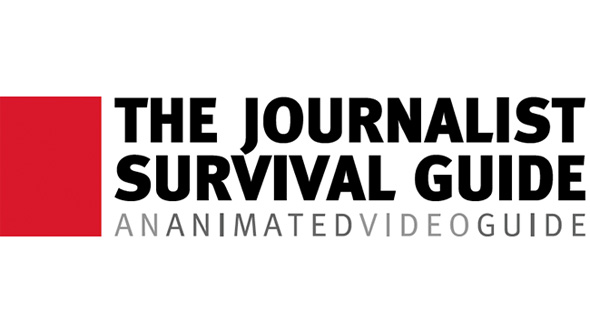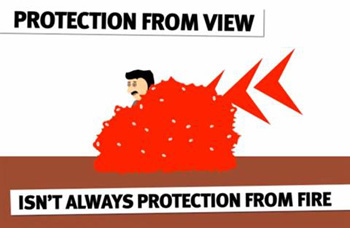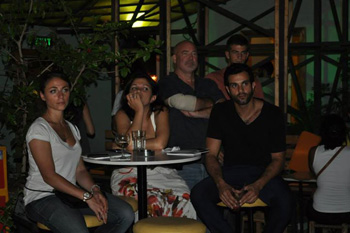Samir Kassir Foundation releases “Journalist Survival Guide” for covering conflict
The Samir Kassir Eyes (SKeyes) Center for Media and Cultural Freedom recently debuted a unique Journalist Survival Guide, blending video with helpful “how-to” tips on what journos should do under fire; during a riot or when chocking on tear gas, and other dangers encountered by media professionals operating in conflict and war zones.

Samir Kassir Foundation releases “Journalist Survival Guide” for covering conflict
By T.K. Maloy
BEIRUT – The Samir Kassir Eyes (SKeyes) Center for Media and Cultural Freedom recently debuted a unique Journalist Survival Guide, blending video with helpful “how-to” tips on what journos should do under fire, or while caught in a riot, when possibly choking on tear gas or if a colleague needs emergency medical assistance, to name a few of the lessons in danger that media professionals can expect to encounter operating in conflict or war zones.
The first Survival Guide lesson leads journalists through the technique for staying safe if they are suddenly caught in the middle of crossfire — top suggestions: behind large rocks, buildings or trees. Lesson one advises waiting until 20 or 30 minutes after the firefight is over to emerge and move on.
The organization said in a statement that the Survival Guide was a “first of its kind video training curriculum providing journalists and citizen journalists operating in dangerous zones with tips and recommendations to protect their physical and online safety and reinforce the credibility of their reporting.”
The center added that the guide includes 14 short animated videos, available in English and Arabic, as well as the scripts in PDF one-page format. “The guide does not pretend to be a full training curriculum on safety and security matters but aims at delivering the most essential recommendations to media professionals and citizen journalists in an easily downloadable and sharable format.”
The release of the Survival Guide comes at an important time for media workers as hundreds of journalists have flocked to Syria and bordering countries, for coverage of the ongoing Syrian civil war which has resulted in the death of an estimated 100,000 Syrian citizens, along with the death or hostage-taking of a number of media workers.
The first Survival Guide lesson leads journalists through the technique for staying safe if they are suddenly caught in the middle of crossfire — top suggestions: behind large rocks, buildings or trees. Lesson one advises waiting until 20 or 30 minutes after the firefight is over to emerge and move on.
Other lessons deal with making contact with sources and protecting their identity; while another lessons deals protecting a computer from hacking, malware and protecting sensitive data through encryption. The lesson also notes the importance of not giving away vital personal information (such as your location) or military information on social media.
Also, much like the well-known “Hostile Environment Schools” given by various security companies for media and corporate executives, there is a lesson on giving first-aid and stabilizing a wounded victim before professional medical staff can reach you.
Additionally the guide reminds correspondents of the rules of international humanitarian laws regarding warfare for dealing with civilians, including children, the elderly and infirm; and ethical treatment of combatants who are no longer fighting, and wounded combatants.
This is more on an informational basis, as such humanitarian law, including the Geneva Convention, are meant to guide the conduct of combatants during active fighting and not media workers.
Ayman Mhanna, executive director of SKeyes, said that the concept for the project was developed last year, with designing and production starting in March of 2012.  As part of putting together the production, SKeyes consulted citizen and professional journalists in Syria and Egypt to identify key issues of risk and security in covering conflict.
As part of putting together the production, SKeyes consulted citizen and professional journalists in Syria and Egypt to identify key issues of risk and security in covering conflict.
The Survival Guide video had its first public showing recently at the Coop D’Etat rooftop lounge atop the Saifi Urban Gardens Arabic Institute in the Gemmayzeh neighborhood. A popular watering hole for journalists, expats and Lebanese intelligentsia, the rooftop is often the venue for music on Fridays. Beirut-based production house Kook Creative Studio created the guide’s animations.
“We wanted to provide journalists and citizen journalists operating in danger zones with quick, practical reminders of the most essential ways to stay safe,” Mhanna said. “Very often, those who cover conflict and unrest don’t have time to go through long presentations, big books and multi-day training workshops. Having short videos with the most important tips might prove useful; people can watch these videos on their mobile phones.”
Mhanna added that “SKeyes would like to thank the National Endowment for Democracy for making this project possible, as well as the Lebanese Red Cross, the Global  Center for Journalism and Democracy, and the National Democratic Institute for International Affairs for volunteering to develop the curriculum.”
Center for Journalism and Democracy, and the National Democratic Institute for International Affairs for volunteering to develop the curriculum.”
Thus far, the guide has been distributed to over 5,000 recipients via SKeyes mailing list and through partner organizations who posted information and links to the project on their respective websites.
For those interested they can view or download copies of the Survival Guide at:
English – http://video.skeyesmedia.org
Arabic – http://ar.video.skeyesmedia.org